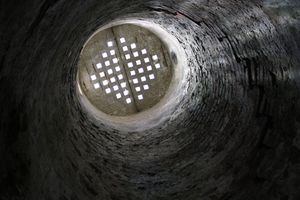Oubliette
An oubliette was a form of dungeon which was accessible only from a hatch in a high ceiling. To exit an oubliette was nearly impossible without outside help. The word comes from the French language oublier, "to forget," as it was used for those prisoners the captors wished to forget. Most prisoners were left to die of starvation.
Another form of oubliette was a shelf in a long steeply sloping tunnel leading down to the moat or to the sea. Once cast down the tunnel, a victim would either slowly starve or cast themselves further down to drown.
The earliest use of the word in French dates to 1374, but its earliest adoption in English is Walter Scott's Ivanhoe in 1819: "The place was utterly dark - the oubliette, as I suppose, of their accursed convent." (OED) There is no reason to suspect that this particular place of incarceration was more than a flight of romantic elaboration on existing unpleasant places of confinement during the Gothic Revival period.
At Leap Castle in Ireland workers discovered an oubliette. There are spikes at the bottom of this shaft, and when workers were cleaning it out, it took them three cartloads to carry out all the human bones at the bottom. A somewhat chilling report indicates that these workmen also found a pocket watch dated to the 1840's amongst the bones. There are no indications of whether or not the oubliette was still in use in that period.
There is an excellent example of an oubliette at the chateau in Meung-sur-Loire near Orleans in France. This consists of a submerged structure close to the castle. There is an opening at the top which reveals a large circular stone-clad pit, approximately twenty meters in depth, approximately five meters across, with sheer walls. It has a central hole in the floor, a pit within the pit, the lower pit being used for excrement and dead prisoners.
One example of what might be popularly termed an "oubliette" is the particularly claustrophobic cell in the prison of Warwick Castle, in central England. The access hatch consists of an iron grille secured by a hasp and (now) padlock.
Other meanings
Oubliette is also used to refer to ice formations over lakes or other large bodies of water. As ice crystals formed, and air was introduced in the movement of the tides, tunnels would form under the ice.
See also Immurement
Chat rooms • What links here • Copyright info • Contact information • Category:Root
